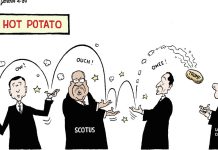According to an annual survey done for the National Retail Federation, more than 171 million Americans plan to celebrate Halloween this year, spending an average of $82.93, up from last year’s $74.34. Total spending is expected to reach $8.4 billion, an all-time high.
More than $8 billion spent on Halloween? Wow! At our house, total Halloween expenditures will be the cost of buying and mailing cards to our five grandchildren. We aren’t buying candy this year as almost no trick-or-treaters hit the streets of our neighborhood on Halloween. The years we have bought candy we’ve ended up eating nearly all of it ourselves.
I don’t blame the kids for avoiding our neighborhood. Though the NRF’s survey found that seven in 10 consumers plan to hand out candy, very few of our neighbors turn on their porch lights. So it’s slim pickings for those hoping to stuff their candy bags in our neck of the woods.
But that doesn’t necessarily mean our neighborhood is anti-Halloween. Maybe, like us, our neighbors have stopped handing out candy because very few ghosts and goblins ever show up, sticking them with pounds of tempting chocolate.
If I’m spending less than $20 on greeting cards and the average American is spending $83 on Halloween, then a lot of Americans must be spending more than $83. Way more. Some of that money goes for decorations and costumes, as the survey said nearly half of all Americans will decorate their home or dress in costume.
If setting a pumpkin on the porch counts as decorating your home, then I guess we qualify. But dress in costume? That’s not going to happen.
When did Halloween get to be such a big deal anyway? And why? My wife said maybe it’s just an excuse for people to dress up and get drunk. I hope that’s false, especially for the children.
But Halloween definitely isn’t just for kids — or even adults with kids. According to the NRF, millennials (ages 18 to 34) are now the most likely of all adult generations to participate in Halloween. They’re also among the top spenders on Halloween costumes.
When I was a kid trick-or-treating, I wore the same costume every year. I put on one of my dad’s flannel shirts and tied the corners of a bandana together and hung it from the end of a stick. Dad smeared a little burnt cork on my face and voila, a hobo. Total cost: 1 cork.
When I got too old to dress up and collect candy, I drifted to the darker side of Halloween. My buddies and I focused on the trick part of the equation, leaving the treats to the younger kids. We started out by rubbing bars of soap on car windows, a crime known as soaping.
Eventually we discovered sticking horns.
In those days car horns were sounded by pressing on a semicircular metal ring between the wheel and the steering column. We would find an unlocked car and thread a strip of wood, called a slat, under one side of the wheel, over the horn ring and under the other side of the wheel, then run like mad. This depressed the ring and the horn sounded until someone came and removed the slat, or, on rare occasion, the battery ran down.
Oops.
Thankfully, later generations have pretty much abandoned our tricks. Modern cars don’t have horn rings, and owners are less likely to leave them unlocked. And I can’t remember the last time I saw a soaped window.
So if Americans want to spend $8.4 billion on Halloween, I say go for it and have fun. And if you happen to get any candy you don’t like, I’ll be glad to take it off your hands.
Or maybe I’ll buy a couple of bags just in case the trick-or-treaters come by. This might be the year we get a whole crowd in our neighborhood. We might even run out of candy.
Unless I accidentally turn off the porch light before it’s all gone. Then I guess I’ll have to get rid of the extra somehow. I have some ideas.
Happy Halloween.
P.S. Last week’s column about spokesman Paul Marcarelli was intended to be a lighthearted piece about characters used in TV advertising. I missed the mark, as I sometimes do. It was not, in any way, my intent to cast Mr. Marcarelli, an actor trying to make a living, in a negative light.
Doug Showalter can be reached at 379-5625 or [email protected].




